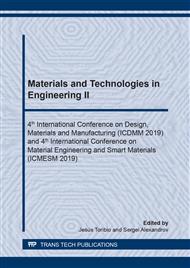p.3
p.9
p.18
p.24
p.33
p.41
p.50
p.55
Hydrogen-Induced Microstructure Optimization of the Ti-6Al-4V Alloy
Abstract:
To obtain advanced materials through the development of traditional materials without the addition of another alloying element, advanced heat treatment can be used. One such innovative process is a thermo-hydrogen treatment (THT); it facilitates a purposeful adjustment of an improved microstructure using hydrogen as a temporary alloying element within heat treatment. In this paper, the five-step process of homogenization, hydrogenation, solution treatment, dehydrogenation, and aging was used in THT. Scanning electron microscopy (SEM), energy dispersive X-ray spectroscopy (EDX), backscattered electron (BSE), electron backscatter diffraction (EBSD), and X-ray diffraction (XRD) were utilized to analyze the phases and phase transformations in Ti-6Al-4V. Three different homogeneous microstructures were established for the investigation using different homogenization parameters values. The hydrogenation was carried out for these microstructures via hydrogen gas charging leading to hydrogen concentrations for the formation of hydride (δ TiH2). After the solution treatment at a temperature above β transus temperature (Tβ), the metastable phases of a martensitic structure consisting of a mixture of α ́ (hcp) and α ́ ́ (orthorhombic) was found. Steps 4 and 5 of THT were a vacuum annealing (hydrogen degassing) followed by aging treatment. The aging treatment was applied to complete the martensite phase decomposition and the precipitation of two phases. By means of this THT cycle, very fine equiaxed microstructures could be established. These microstructures consist of the αs phase (secondary α) in the β phase matrix and the α2 phase (Ti3Al) in the αp phase. The precipitation of these phases increases the strength of the Ti-6Al-4V alloy and, consequently, enhances the mechanical properties. No evidence of the δ phase was found.
Info:
Periodical:
Pages:
24-32
Citation:
Online since:
April 2020
Authors:
Price:
Сopyright:
© 2020 Trans Tech Publications Ltd. All Rights Reserved
Share:
Citation:


